Saturday, again, and definitely heading to Autumn, with dew-damp ground in the morning as well. I am seriously going to have to start wearing shoes, or maybe even boots - not because of the cold, and damp, but because of the apples, which are supremely squelchy amidst the tall grass that seems to grow better beneath the tree than it ever does on what is supposed to be the lawn.
This week, hit and miss. A couple of days had to be changed midstream, but we will speak of those later as we go along. One turned out to be good fortune though, as it has provided me with what I think is another set by Ch. Jux, and a while ago I was contacted by a descendant of theirs, asking for any information I could find. Even better, we had only come to their attention through a search engine finding one of the cards we feature on this site.
So on to the filling in the sandwich, as it were , as let us start with :
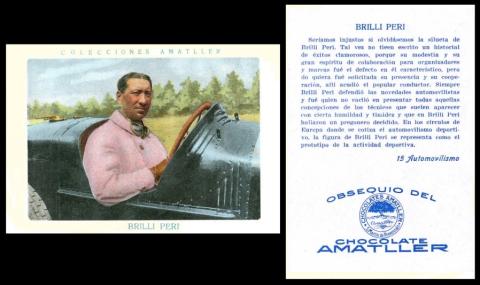
Chocolate AMATTLER [trade : chocolate : O/S - Barcelona, Spain] "Automovilista" / [race car] drivers (1928) 15/??
Let us begin this week`s journey with a centenary, for today, in 1925, Count Gastone Brilli-Peri won the Italian Grand Prix, in an Alfa Romeo, a P2, and won them the manufacturer`s championship title for that year.
Now that "Count" was not an assumed title, it was a real one, he was actually a Count, from the time he was born, on the 24th of March, 1893.. His first love was cycling, and his first race in 1907. He found the delight of pedalling about quite amazing, until 1912, when he bought a motorcycle, and found that not only did this remove the need to pedal, but the machine went all the faster for it. In 1914 he not only entered his first motorcycle race, but had his first win. And he would continue to enjoy motorcycling, even after an incident, in race, that left his face permanently scarred.
His racing career was temporarily curtailed by the beginning of the First World War, in some ways, for he managed to find a posting that involved a motorcycle. I cannot find out what this was, but given his noble birth he seems unlikely to have been a simple scout, or courier, it seems more likely that he would have joined what was known as the Bersaglieri - which was like the cyclists corps of the British Army, but each battalion also having a pair of motorcycles, armed with machine guns. The Bersaglieri also had a very fetching hat with a long plume, something which would definitely have been a huge encouragement to our man, who loved smart dressing almost as much as he loved speed. It is no secret that he also loved hats, as when he raced, he wore a beret, not a helmet - and rather charmingly, in Italy, his kind of beret was quickly named after him. It is said that this still continues, to this day, but I am not sure any fame lasts that long - though Montevarchi stadium is still named in his honour, so perhaps it may be so.
In June 1923 he turned up in a car, a Fiat, in a motor race, the Grand Prix of Brescia, but did not finish. He next raced in 1927, taking part in the Mille Miglia, or thousand mile race, which was more endurance than speed, and had to have two drivers, swopping from time to time, to prevent sleep-related incidents. His co-driver was Bruno Presenti - and the Fiat had been replaced by an Alfa-Romeo, but his bad luck continued and again the car did not make the end of the race. However he was back the following year, with a Bugatti, and a new co-driver, Signore A. Lumini, about whom so little is known that I cannot even replace that initial with his Christian name. This time the car came home sixth. And Count Brilli-Peri was also fourth, driving alone, in another Bugatti, in the German Grand Prix, in July 1928.
The following year saw him back in the Mille Miglia, but in an Alfa Romeo, and teamed with another new co-driver, Carlo Canavesi, but again they did not finish the race.
1929 saw him at last take the chequered flag, winning the fifth Tripoli Grand Prix, in a Talbot, on March the 24th. Later in the year he would win again, at Cremona, on September the 29th, and, at last, in an Alfa Romeo.
Buoyed up with these results, he returned to Tripoli in March 1930. But during the practises, before the race he crashed at a bend, and was thrown from the vehicle, dying almost instantly. The date was the 22nd of March, just two days before his birthday.
Sadly it looks like this is the only card of him. It was issued with chocolate and is a lovely set, if you can find all the cards, which is getting harder. I have a small list, but not yet any idea of how many of them make a set - maybe you do, and can add some of the missing names. By the way, the cards only give the surname of the racer, but I will be able to fill them in and add them to this list, in square brackets, as below.
1. [Lili] Alvarez - a female driver!
5. [Arturo] Gaston
8. [Jimmy] Murphy
10. [Henry] Segrave
15. [Gastone] Brilli-Peri
19. [Albert] Divo
22. [Robert] Benoist
23. [Lucien] Desvaux
Many of these brave men, and women, do not seem to appear on any other set, which makes this even more of a prize to own, even in parts.
By the way Amatller also issued another set, similar, but the full title of that is "Carreras Automovilisticas", which translates to motor sports - this is slightly later and seems to concentrate on the actual races rather than showcasing the drivers. However, before you get too excited, it is even scarcer than this set.
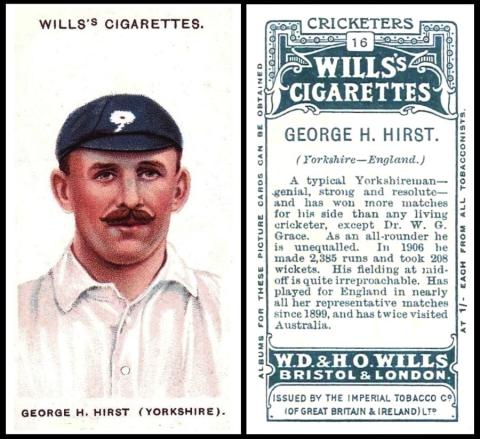
W.D. & H.O. Wills [tobacco : UK - Bristol] "Cricketers" (May 1908) 16/50 - W/58
This day eluded me for a while, or rather I spent too long trying to find a card for "Pool Pro Day", celebrating the menders and builders of swimming pools.
Anyway I then discovered that it was also the birthday of George Hirst, cricketer, as seen on our card, so the pools will have to wait until next year, maybe.
George Herbert Hirst was born today in 1871, in Kirkheaton, West Yorkshire, then a village near Huddersfield. He was one of ten children, and his father died when he was only nine, which led to him having to leave school and go to work. He started out playing rugby, and then tried cricket one summer, to find he not only liked it, but was very good. That led to him being snapped up by the Kirkheaton team, aged just fifteen, and, aged nineteen, joining the Yorkshire County team as well.
His cricket career, with Yorkshire County Cricket Club, ran between 1891 and 1921, and from 1897 until 1909 he was also on the England Team, touring Australia twice. The first one of these is recorded on two cards issued by the National Cigarette Company of Australia, with their "Tally Ho" Cigarettes, in 1898. According to the Trading Card Database, he appears on sixty cards, split into two groups, the first, issued during his playing career, ending in 1926 with appearances in Gallaher`s "Famous Cricketers" and Pattrieouex`s"Cricketers", The other cards are either reproductions of those cards, which began to be issued in 1980, or modern cards which use older images from the press etc, which are therefore kind of new/kind of reproductions.
Sport stopped at the start of the First World War, during which he worked in a Munitions Factory. After the war ended, he took a job as a cricket coach for Eton College, which lasted until the outbreak of the Second World War - though he did return, briefly, to the field in 1929, and in the 1930s he was occasionally seen acting as an umpire.
He was an amazing cricketer, getting the sought-after feat of a thousand runs and a hundred wickets no fewer than fourteen times, only Wilfred Rhodes doing the double more. He also scored almost thirty-seven thousand four hundred runs, and taking almost three thousand wickets. And yet, today, he seems so little known, though he did not die until 1954, at the age of eighty-two.
The first important thing about this set is that it is actually called only "Cricketers", and so it is described in our original Wills reference book part three, or "RB.14 – The Cigarette Card Issues of W.D. & H.O. Wills Parts I and II (revised) and Part III", published in 1949.
. This entry reads :
- 58. CRICKETERS - known as "Cricketers 1908". Fronts lithographed in colour; backs in blue grey with descriptive text. Home issues, 1908 -
A. Nos. 1-50 with small last "s" to "Wills`s" at top front
B. Nos. 1-25 with large last "S" to "Wills`S" at top front.
Two varieties of cards Nos. 2, 5, and 25 are found, and have been seen as follows :
No.2 Without blazer A
With blazer AB
No.5 Without cap A
With cap AB
No.25 Without blazer A
With blazer A
Now in our Wills reference book part four, RB.16, which is actually "The Cigarette Card Issues of W.D. & H.O. Wills Parts I, II, and III (revised) and Part IV", published in 1950, there has been a change, and not just to the title, which has added the date permanently in.The entry reads :
- 58. CRICKETERS, 1908 - see page 97
Add letter "B" to No.25 - With blazer
Sadly, this does not explain whether the "B" was omitted in the original book by accident, or whether it has been a new discovery since that book was printed. But I may be able to find that out in the magazines, for there is only a year to work through between the printing of one booklet and the next.
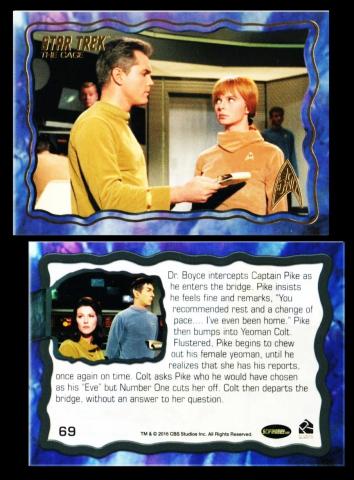
RITTENHOUSE [trade/commercial : cards : O/S - USA] "Star Trek The Original Series - 50th Anniversary" - "The Cage, Uncut" (2016) /70
Today in 1966 reputedly saw the screening of the first ever episode of Star Trek. That is actually incorrect, for it had been shown already, in Canada, on the 6th of September - so today was technically the first episode of the series ever to be shown in America.
In actual fact, this episode, called "The Cage", was actually a pilot, rather than the start of the series. It was written by Gene Roddenberry, and shown to the officials at NBC in February 1965, who hated it, and that was almost the end of the series before it ever hit the small screen, however they agreed to watch another episode as well, and that went down better, with them agreeing to fit the series into the regular schedule.
As for "The Cage", it was never screened in its original place or format, though some of the footage was used in another episode shown during the first season, called "The Menagerie", which tells the story of an alien race who keep other species in a kind of zoo, and are hunting for a male human to join it.
The first time "The Cage", in its restored state, was seen by the general public was on a home video, and not until 1986, and then it was shown on American television two years later. It was not shown in the United Kingdom until August 1992, on BBC2.
Despite its limited screenings, it is a favourite with fans, because of many things, not least that one of the actors is Leonard Nimoy, playing Science Officer Spock, the only character, and actor, who appeared in the pilot and in the series which followed. The USS Enterprise was under the command of Christopher Pike, played by Jeffrey Hunter.
And also historic is the fact that in this episode, Spock delivers the very first line ever spoken in the series - which was "Check the circuit!"
This is a set of many parts, starting with an eighty-card base set, with white borders, and, inside a decorative frame, four pictures. In the very centre, where all pictures join, there is a golden logo,the Star Trek V shaped wings.
However, as is becoming usual in these times, there are also extras, including various styles of autographs, bridge crew heroes, cut signatures (in mounts to make them the same shape and size as the cards), concept art and sketches, printing plates, and a nine card set that remembers Leonard Nimoy, who died in 2015.
Lastly, there are three insert sets that deal with two single episodes, two sets covering "Mirror Mirror", and one set, our set, on "The Cage", which on its own comprises seventy cards, examining the episode in minute detail. The chance of getting one of these insert cards in a standard pack are slim, as they were only issued one card in every twelve packs. But if you think that hard, compare it to "Mirror, Mirror Heroes", which was distributed only one card in every two hundred and eighty-eight packs, and our odds are suddenly not so bad.
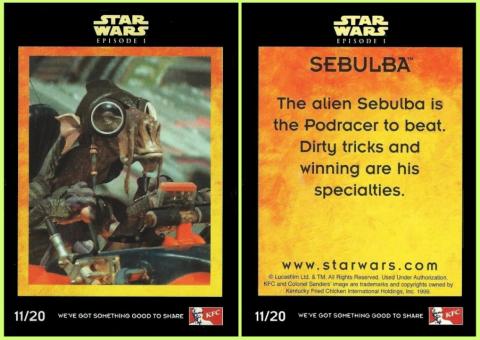
KFC/Kentucky Fried Chicken [trade : food : O/S - Kentucky, USA] "Star Wars, Episode One" (1991) 11/20 -
The character on our card, Sebulba, was a Dug, and a slave, from the planet Malastare. He somehow became involved with pod-racing, and was good, good enough to pull off the amazing feat of being able to buy his freedom - but only because he found a way to cheat the system, knocking other racers off the track without a qualm, and installing illegal devices that gave him the edge above all those who complied with the rules.
However, it is not really he whom we celebrate today - for that we go back, to 1890, when, today, a man called Harland David Sanders was born, in Henryville, Indiana. His father was a farmer, but had a fall which left him with a permanent limp, so he had to give up the farm and find employment, as a butcher. But he was never the same, and died in 1895. His mother had to go to work, and he was left to look after the other children in the family,. Reportedly this is where he taught himself to cook.
In 1899, his mother remarried, but her husband also died, within a year. This time she stayed at home and our man went to work. It seems likely that she was already dating someone else, and they married in 1902. The new husband seems to have had a temper, and by the age of twelve our man had moved out and got himself a live-in job at a local farm, though he did not settle, and kept on moving on from farm to farm. Eventually, aged sixteen, he went to live with his uncle, who worked on the trains and took him on as a conductor.
This was fun, for a while, but soon grew tiresome. Coincidentally, he saw a poster for the Army, looking for men to go fight in Cuba, so off he went. He was discharged the following year, and moved to Alabama, where his uncle was now living, and where he was reunited with one of his brothers, who had also run away from home. Both the boys seem to have been taken on by the railways, thanks to their uncle. It was there that he met his wife, and they were wed in 1909, going on to have three children over the next ten years. During this time he lost his job, and the family split up. He found employment, in a law firm. for three years, whilst he got his family back together, and then his temper got the better of him and he was fires Yet again he lost his family, and he moved back in with his mother, going back to the railroads, but only as a labourer. However, in due time, the family were once more reunited. This seems to have gone on throughout his lifetime, he would get a job, and then lose it, sometimes through no fault of his own, and sometimes because he was too proud to admit he was in the wrong.
In 1930 he was living in Kentucky, running a service station which was forced to close in the Great Depression. However the owners of that station, Shell, offered him another place, rent free, so long as he paid them a percentage of everything he made. He knew he would not sell much petrol, so he had the brainwave of serving meals. One of his best sellers was fried chicken, and he kept on refining the recipe, even after he lost the service station, and his motel venture was burned to the ground.
He seems to have separated from his wife by this time and taken up with another lady, who he married in 1949. By this time he was an honorary Colonel, given by the State Governor to people who have done good things for the community. That came in useful when, in 1952, he offered his secret fried chicken recipe to the man in charge of a chain of restaurants in Utah, in exchange for a share of the profits - four cents per chicken. It was the restaurant that hit on the name "Kentucky Fried Chicken".
Eventually the franchising spread to Canada, and even to Jamaica, but by then Colonel Sanders was getting old, and it was spreading too fast, and he sold the whole corporation to businessmen in 1964 - when he was seventy-four. They also wanted him to stay on the books, and paid him for being their brand ambassador, which also allowed him to travel - and he also kept the Canadian operations.
He remained part of the business until 1980, when he died of Leukaemia, at the age of ninety. Thousands of people attended his funeral, and he was indeed buried in his full Colonel Sanders costume.
These cards were issued in 1991 to celebrate the release of "Episode One" of the Star Wars films, which was actually the fourth film to be shown. They are larger than normal, and usually turn up as complete sets, though at the time they were issued one at a time, with a meal. Apparently they were also issued in Australia and Malaysia, but I am not sure if they are exactly the same.
The list of cards are :
- Qui-Gon Jinn
- R2-D2
- Jar Jar Binks
- Queen Amidala
- Shmi Skywalker
- Obi-Wan Kenobi
- Senator Palpatine
- Mace Windu
- Destroyer Droid
- Jabba the Hutt
- Sebulba
- Yoda
- Darth Maul
- C-3PO
- Watto
- Padmé
- Battle Droid
- Nute Gunray
- Darth Sidious
- Anakin Skywalker
Set A Title Card, 1-10 (unnumbered)
Set B Title Card, 11-20 (unnumbered)
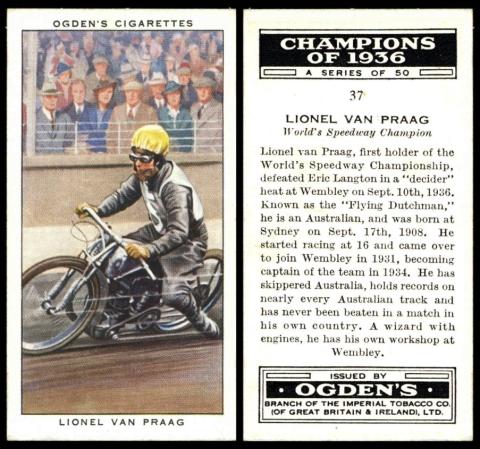
Ogden`s [tobacco : UK - Liverpool] "Champions of 1936" (1936) 37/50 -
I may have used a card from this set before, but I could not resist using this one, as it celebrates the same event as we do - for today, in 1936, saw the final of the first Individual Speedway World Championship, held at Wembley Stadium, and the winner was an Australian, Lionel Van Praag. However this was actually just a new name and slightly different format to what was known as the Star Rider`s Championship. And it was not the first time that speedway had come to Wembley, either, that had been on the sixteenth of May 1929, and it was won by Roger Frogley.
Lionel Maurice Van Praag, showing here, was born on the seventeenth of December, 1908, in Redfern, Sydney. I have not been able to find out much about his early life, yet, except he was an only child and his father was a tram conductor in Sydney. It seems he jumped on a motorbike at an early age and never looked back. Though we know that he went to technical school, and was a very capable mechanic.
His speedway racing debut came, in July 1926, whilst still a teenager, shortly after the Speedway Royal had opened in Sydney. He took to competition and started touring around, right across Australia and New Zealand, and then got the chance to join a group of Australians who were coming to England to compete and give shows. He got an offer from the Wembley Lions, and joined them in 1931, taking them to the top of what would turn out to be the last ever Southern League table, and also winning the National Trophy. The next year, they won the National League title, which was the replacement for the Southern and Northern Leagues.
For some reason, perhaps the two "a"s in his name, he picked up the nickname of "The Flying Dutchman", and he was certainly very well followed by fans, regularly coming top in polls. It seems likely that this was why he was asked to appear in a feature film, "Money for Speed", starring John Loder and Ida Lupino, and released in 1933..
It is about this time that our card, and the Speedway World Championship, came along. The text tells us simply that he "defeated Eric Langton in a `decider`, but there is still debate about this match for the title, over several issues, the first of which concerns the fact that the way the competition worked was a points accumulator, and Bluey Wilkinson was a long way ahead. However he was not in the final, due to a sudden award of bonus points, to our man and to Eric Langton. Then, in the final, just as they lined up behind the tapes, ready to start, Eric Langton broke them, something which would have been grounds for a race, and even a final, for automatic disqualification, and in the case of a final, see the trophy awarded to the other rider without the race going ahead. However Mr. Van Praag was adamant that he wanted to race, not take the title by default, and so they raced, and Mr. Van Praag won. But even after that there was controversy, with stories emerging as to the fact that it had all been fixed, between the two racers, not officially - and that they had set up an arrangement whereby whichever one of them got past the first bend first would be allowed to win the race, with the prize money being split between them later. Now Mr. Langdon got to the first corner first but was overtaken by Mr. Van Praag. One story even says that because the arrangement was not fulfilled, Mr. Van Praag felt a bit guilty, and actually took less of the purse than the half which he had agreed. However, we will probably never know the truth of this.
He also appeared in the next two World Finals, also at Wembley, coming seventh and sixth respectively. He had also been learning to fly, and when the Second World War broke out he enlisted in the Royal Australian Air Force, becoming a pilot. During his service he was awarded the George Medal for bravery, helping to save two members of his squadron from drowning and being eaten by sharks, after their aircraft was shot down in Indonesia, and they were forced to spend over thirty hours in the water, a feat made even more incredible by the fact that one of those men was slipping in and out of consciousness, and the other could not swim.
He did race again, but gave up in the late 1940s, finding out he liked flying better; in fact he became a commercial airline pilot, and also worked for a company that flew over lands for surveying purposes .
He died on the 15th of May 1987, in Brisbane, Australia, leaving behind his second wife, and four children.
And he was added to the Australian Speedway Hall of Fame in 2008
You can see him on several cards, namely :
- 1937 : Ogden`s "Champions of 1936" (37/50) - our card
- 1937 : John Player "Speedway Riders" (46/50) -
do note this was reprinted in 2000 for the Card Collectors Society - 1937 : Godfrey Phillips "Sportsmen - Spot the Winner" (17/50)
- 1948 : A & J Donaldson "Sports Favourites" (404/512)
- 1999 : J.F. Cards "Speedway All Time Greats" (19/24)
- 2000 : J.F. Cards "Wembley Speedway Stars, series two (19/21)
In the 1950 London Cigarette Card Company catalogue this set was listed at 2d a card and 10/- a set. This set was also issued by Hignett (H536-430) and in that same catalogue it gives a sale price for this version of 6d. a card and 30/- a set.
Intriguingly, whilst the Ogdens version only has a year, the Hignett gives a month of issue, namely June 1937.
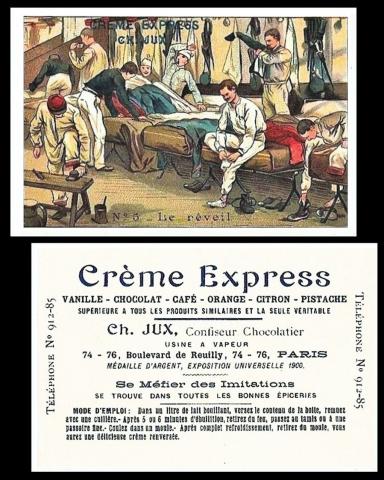
Ch. Jux [trade : coffee : O/S - Paris, France] "La Vie du Soldat" (19??)
This was the other card that got changed, after I had spent ages hunting something to record the first ever Milwaukee Mile, which happened today in 1903.
Then I stumbled on the fact that it was National Make Your Bed Day, and though this card does not show the act of bedmaking, these men are just getting up, so that will surely follow.
Though in fact you are not supposed to get out of bed and cover it straight up, as that traps the bodily outputs of the night before (and the scent of wet dog, in my case, after a rainy night, of which there have been a few lately, more`s the pity)
I have also taken a liberty of inventing a title that translates to the life of a soldier. They certainly look regimented, and are on camp beds, but they are too big to be scouts. And when I asked about, quickly, I found a few more, namely :
- L`habillement (dressing)
- Le Lavabo
- Le Reviel - (waking up) - our card
- A L`infermerie
- Le tir (shooting practise)
- Le Corps de Garde
- L`escrime a la baionette
- La marche militaire
- Le billet de Logement
- La revue da General
They are pretty easy to spot, as they have the large, almost rubber-stamped name on the front of the card. So if anyone else has any other cards in this series do let us know.
Now since I wrote this last weekend, we have discovered that there is another printing of this set, by Biscuits Pernot, of Dijon, and it is of twenty-five cards.
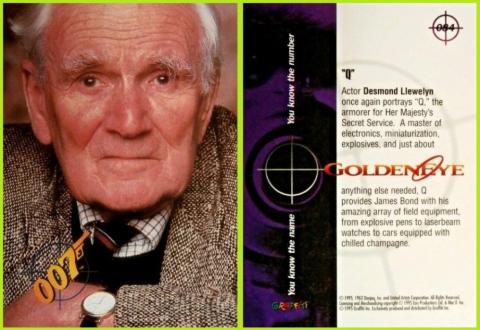
Graffiti [trade/commercial : O/S - USA] "James Bond - Goldeneye" (1995)
Today, in 1914, this man, Desmond Wilkinson Llewelyn, was born. His surname gives it away, and reveals him to be Welsh, born in Newport. Now it is sometimes told that he was the son of a coal miner, but this is not true, especially when you learn that his father bought the first ever production Bentley direct from Mr. W.O. Bentley himself, in 1921. In fact his father was involved with coal mines, but as an engineer. If you wonder how this enabled the affording of the Bentley, well that came from his father, Llewelyn Llewelyn, who was not just the general manager of the Powell-Dyffryn Steam Coal Company, but the High Sheriff of the whole of Monmouthshire.
Our man wanted nothing to do with coal, he wanted to join the church. However when he was at school, he joined the theatre club, as a stage hand, and was slowly allowed to take more of an acting role, which he found he enjoyed very much. His father was not keen on the church or the stage, it appears he wanted his son to play professional rugby, which was a possibility, but the acting bug caught hold and the chance discovery of a pamphlet about the Royal Academy of Dramatic Art saw an application sent quickly off, and an acceptance quickly follow.
He was twenty years old when he arrived in London, and it did not take him long to become smitten with one of the actresses. They married in 1938. And, out of the blue, shortly after that, he had a job offer, on a film. "Ask a Policeman", with Will Hay. In fact he played a character which today is called "The Headless Horseman", but had no official name and did not appear in the credits.
Perhaps he would have got more film offers, but the Second World War got in the way. He was in the Royal Welsh Fusiliers, and sent to France; things did not go so well though, and they were beating a retreat to Dunkirk when he and his men were captured by the Germans, and he was sent to a succession of Prisoner of War Camps, most notably Colditz Castle. He stayed imprisoned for five years, then came home and tried to rebuild his acting career. His early work was mostly on the stage, which he much enjoyed, and he worked with almost all the big names of the time. In the 1950s and 1960s, he found himself cast in many films, but mostly in a supporting role, not a lead.
In 1963 he was asked to read for a part in a spy thriller. The character was Quartermaster Major Boothroyd, an inventor of gadgets, and he was not just selected because of his military background, but because at the time Ian Fleming had wanted someone who spoke Welsh. Later on, with much convincing having gone on by our man, Ian Fleming agreed that maybe an English accent would work better - and he was also instrumental in shortening the man`s name, to the simple initial "Q".
He first played "Q" in "From Russia With Love", released in 1963, and he appeared in every Bond film until his death, bar one - "Live and Let Live"; seventeen films, opposite five different James Bonds.
The reason for his non-appearance in that one film is unclear, the character was in the book, and the makers did contact him, which led to his agreeing to take time off from a series he was currently appearing in, but it was later decided not to use him after all.
He was killed in a car crash, in East Sussex, on the way back from a book signing event, in December 1999, just three weeks after the Premiere of "The World is Not Enough". He was aged eighty-five.
Now actually, this is quite an important set, because it was whilst making this that it was decided to change the company name, from Graffiti, to Inkworks - and you can get a card that announces this, though it is very scarce, mainly because it was not thought to be very important at the time. Now, with hindsight, we greatly regret this, as collectors of Inkworks cards would really love to add one to their collection.
This set had inserts, but not so many - a couple of puzzles, which cigarette card collectors call sectional series, to be laid in a long strip and form the phrases "007" (in three cards) and "Bond, James Bond" (in nine cards) - and a set of proper cards called "Gadgets of Q", which comprised six cards - of a Laser Beam Wristwatch, a Grappling Hook Belt, a Grenade Pen, a couple of guns and a BMW Roadster 23 car.
This week's Cards of the Day...
...took us back to school, with the end of the Summer Holidays. Though I did feel that this may not be a very popular subject, especially with our younger readers.
The thread examined some of the good, and bad, things about going to school, and wondered whether there would ever come a time when schools were replaced by online learning, or memory chips, inserted at birth.
We started the week with
Saturday, 30th August 2025
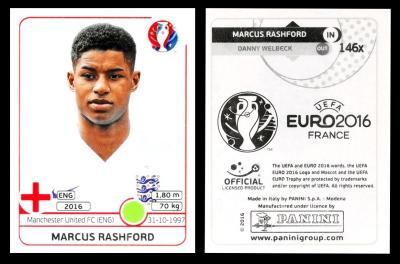
School and football may not seem to have anything in common, but then I thought of Marcus Rashford, who has been instrumental in supplying free school dinners by way of his #MakeTheUTurn campaign, which saw free school meals continue even when the schools were closed for the summer.
Marcus Rashford was born in Manchester on the 31st of October, 1997, and who was signed by Manchester United at the age of seven, after being spotted during a match involving his first team, Fletcher Moss Rangers, though, strangely, he was their goalkeeper. Being signed at the age of seven does not mean that he ran straight on the field that Saturday with all the adults towering over him, he had lots of training, and regular schooling, first, and then joined the Under-15, Under-18, and Under-19 squads. In fact his first outing for the Manchester United first team was not until 2016.
He also made his debut in the England Squad that year, and scored in that match, becoming the youngest English player to score in his first senior international match.
He stayed with Manchester United until 2025, then was loaned out to Aston Villa and Barcelona. After that, he was loaned to Barcelona, where he chose to stay on, and remains to this day, though he is still technically on loan.
This is one of the sub sets that were allied to Panini`s base set of six hundred and eighty cards for UEFA 2016, the others being either circulated in certain countries (Albania, Austria, France, Hungary, Poland, Spain), or distributed at eateries or with food and drink (Coca-Cola. McDonalds).
Oddly, the latter cards were given free with any purchase, and the Spanish and French started out by giving packets away in magazines - so that makes those ones trade, rather than commercial, but sadly there is no way of telling which were trade and which were commercial with the Spanish and the French ones.
Sunday, 31st August 2025
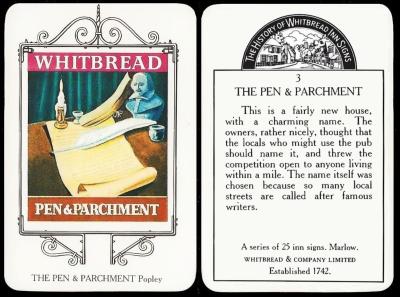
Here we have one of the best things about going back to school, the thought of going shopping, and coming out with new pens, pencils, exercise books, etc.
Now younger readers may laugh at this, because they get a computer, or I-pad. To them, pens, and pencils, and having to physically form letters, are almost antiquated. And, sadly, when I was at school, we used to think much the same when we were shown quills and parchment.
Unfortunately I have not been able to find much out about this public house, only what it says on the reverse, that it was "fairly new", and that "The owners, rather nicely, thought that the locals who might use the pub should name it, and threw the competition open to anyone living within a mile. The name itself was chosen because so many local streets are named after famous writers". From other sources I gleaned that the town was once very rural, and at around the time of Edward the Confessor was on and off the property of the Manor of Chineham. The new town was built in the 1960s, and included an area called "Poets", which were indeed named after famous writers of verse. However the pub itself was sited in the middle of a housing estate, was reportedly a little rough, and is now demolished, to make way for even more housing.
Whitbread`s "Inn Signs" fall into several categories, but the main two are the original selection, issued between 1949 and 1958, of which the first set was solely produced on aluminium, and the more recent "History of Whitbread Inn Signs", one of which we feature today. Then there are what purists may call peripheral, or non-cartophilic, the stamps, business cards, postcards, and general memorabilia, like leaflets and pamphlets, which show the signs to advertise them.
Strangely, neither of these main groups yet have a home page. Findings to do with the first group, the originals, is currently being collated under the listing for the second series, which we used as a Card of the Day for the 1st of April 1925. And, until we feature a card from the "Bournemouth" series of the "History of Whitbread Inn Signs", anything we discover about those cards is ending up with the Stratford-On-Avon set, which was our Card of the Day for the 28th of November, 2023
The more modern cards first appears in our British Trade Index part III, along with three groups of 1950-1958 signs which had been discovered and/or produced after our second volume. Our group is described as
The History of Whitbread Inn Signs. 76 x 50. Rounded corners, on board. Special albums issued, 1973-74. Eleven numbered series. ... WHI-2
1. Bournemouth (25 cards)
2. Devon & Somerset (25)
3. Isle of Wight (25)
4. Kent (25)
5. London (10)
6. London (15)
7. Maritime Inn Signs (25)
8. Marlow (25)
9. Portsmouth (25)
10. Stratford-Upon-Avon (25)
11. West Pennines (25)
This varies very slightly in our updated British Trade Index, it is purely altered by moving the date nearer the start of the entry. But there is a new card code for the group, of WHI-120, which is then suffixed by the fact our set is the eighth down.
As far as the signs in the set, they are :
- "The Fox", Ibstone
- "(The) Emperor of India, Farnham Royal
- "(The) Pen & Parchment", Popley
- "The Merrymakers", Langley
- "The Starting Gate", Newbury
- "The Beehive", White Waltham
- "The Blade Bone", Bucklebury
- "(The) Two Brewers", Marlow
- "The Crown & Old Treaty House", Uxbridge
- "The Fox & Horn", Mortimer
- "The Bridge House", Paley Street
- "(The) Downley Donkey", Downley
- "The Full Moon", Hawridge Common
- "(The) Herne`s Oak, Winkfield
- "The Lion", Reading
- "(The) Newtown Pippin", Harmanswater
- "The Crooked Billet", Marlow
- "(The) Marlow Donkey", Marlow
- "The Bull (Hotel)", Sonning
- "The Woodley Yeoman", Woodley
- "(The) Donnington Castle, Donnington
- "The Heart in Hand", Cores End
- "The Live and Let Live", High Wycombe
- "The Jolly Bodger", High Wycombe
- "(The) Jolly Cricketers", Beaconsfield
The hardest one to get seems to be "The Starting Gate" at Newbury. Not sure why. And I am also not sure why this set was called "Marlow" - when it seems to revolve around the counties on the western side of London. Even the location of our sign, Popley is in Hampshire, near Basingstoke, and almost three-quarters of an hour`s drive away.
Monday, 1st September 2025
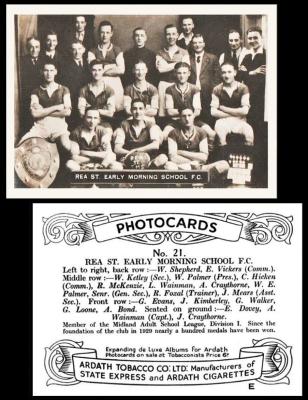
This card was the first to actually say School, but it also gives us something that few children enjoy, and that is getting up early in the morning, after the liberty of the holidays, when they could get up at any time, or not get up at all.
This team - Rea St. Early Morning School F.C. - is impossible to find, it is one of many that disappeared, seemingly without leaving any trace - and yet we have them, on this card.
From the card we know that A. Wainman was the captain, R. Foxal the trainer, and that the staff were W. Palmer (President), W.E. Palmer, Senior (General Secretary), W. Ketley (Secretary), J. Mears (Assistant Secretary), plus C. Hicken and, E. Vickers (who were both "Comm" - whatever that stands for). It also tells us that the club was a "Member of the Midland Adult School League, Division 1. Since the foundation of the club in 1929 nearly a hundred medals have been won ."
Putting Rea St. Early Morning School F.C. in any search engine came up blank. However I did find that the Midland Adult School Union was established by Alderman William White, a Quaker book seller/publisher, and John Blackham, a draper, in 1884, and that the idea behind it was to give education to adults, many of whom has never gone to school and were illiterate. Though it started out to only teach reading and writing, it seems to have expanded into other subjects and even extra curricular activities, like sport. All we need to get straight is whether our team was part of the "Union".
The first thing to note about this card is that we have a homepage for all the "Series" sets of Ardath "Photocards", with our Card of the Day for the 29th of July, 2023, which was the "A" Series. Over there you will find lots of background information, and a link to each of the series, where you will find more information pertaining to each one. One day there may also be a list of all the cards, as it was such fun tapping in the names of the clubs featured on that "A" Series - and also anyone looking for a specific team will be able to track it down as a keyword.
Today`s card is from Series "E", described in our original Ardath reference book RB.6, issued in 1943, as :
- Sept. 1936. 110. Photocards Series "E" (titled series). size 3 1/2" x 2 1/4". Numbered 1-110. Real photographs of Football Teams of the Midlands, toned black and white, glossy finish, titled, white margin. Backs printed in black with description, with "E" at bottom right. Issued with "King`s Cigarettes". Expanding Albums, price 6d., were issued.
Varieties :
- Front Title - Back Title 9. - Kenilworth Early Closers` F.C. - Kenilworth Early Closers F.C. 87. - Newhall Colts F.C. - New Hall Colts F.C.
At the very end of the listing in that original reference book, we have the following;
- NOTE :- PHOTOCARDS of Series A, B, C, D, E, F, the additional series AS, CS, ES, and FS, and part Z (to No.165) are found with the backs overprinted diagonally in red with "Packed with Ardath Kings, 10 for 6d., The Longer Cigarette." These cards were given away at the actual football match. A few of the remaining cards being packed with the cigarettes. It is believed, but not certain, that the complete series were thus overprinted.
The following varieties of overprint have been seen :-
Vertical instead of diagonal - Series A, No. 75
Inverted - Series C No.32, Series E No.88, Series F. Nos. 13/14
Some of the cards were also issued (it is thought to retailers only, as advertisements) with a thin paper cover, printed in brown, hinged at the back and covering the front of the card, advertising Ardath "KIngs"
There is a different overprint reading "only photographs of Arsenal and Manchester City are packed with Ardath Kings sold here today, 10 for 6d." However, we do not think that this was ever added to the cards from Series "E" - unless you know differently?
The above description was shortened for our original World Tobacco Issues Index, and that for series "E" reads :
- PHOTOCARDS - numbered series. Md. Black and white photos. Nd. Many cards found overprinted in red-brown "Packed with Ardath Kings - 10 for 6d. - The longer cigarette". See RB.6 - page 11. ... A72-53
5. Inscribed "E". Football Clubs of the Midlands 110)
This text is repeated in our updated World Tobacco Issues Index, without the reference to RB.6, and with a new card code, of A745-650.
Tuesday, 2nd September 2025
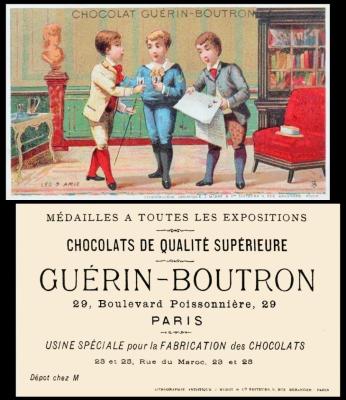
So I will start this write up by asking if there are any other cards in this series, either other adventures of the three friends, or other cards in the same style but with different characters? And if anyone knows who these three friends are?
This week we are speaking of back to school, and it is fair to say that the most important thing of all about school is making friends, or avoiding people who are not your friends. It is not just a case of socialisation, it is about learning trust, and distrust, and how to fit in, or learning how to seek out your tribe of other mis-fits if you do not. Some of these friends will remain with you all through school, and maybe to the next one, maybe even through your life, whilst others will disappear and never be seen again, or even be met, years later, when you do not really recognise them but they are able to remember your most embarrassing faux pas.
School is a time of massive change, especially for the shy, or those with physical or mental differences. Today I hope that the teachers and staff are able to help with all this, and to understand, and to keep an eye on those who require it. However, I am certain that those most in need of help are also those who are the least likely to ask for such a thing.
This card was printed by J. Minot et Cie, editeurs, 5 Rue Beranger, also of Paris. J. Minot was a person, Charles Antoine Joseph Simon Minot, and he was born on December the 28th, 1847. Strangely, though he, and his parents, were French, he was born in Switzerland.
He was married in 1876, quite late, but it appears the bride was wealthy, as he was able to take over a well established printers, in Paris, shortly after the wedding. He also had a partner at that time, about whom very little seems to be known, his name was Guesnu. He was, at one time, listed first in the company name, and there are suggestions that he was part of the printers that Mr. Minot bought into, especially as the name at that time was Guesnu & Minot. This all changed from 1880 and Mr. Guesnu was no more.
Sadly Mr. Minot did not last too long after that, he died on June the 13th, 1901, in Paris, aged just 53. However the company kept the same name for almost a quarter of a century, so perhaps there was a son and heir.
Wednesday, 3rd September 2025

Tonight we will discuss something which can also be seen as good and bad, and that is uniforms.
Most schools have some kind of uniform, and it is often not to the liking of the children, some of whom resent the fact that they cannot just wear comfy clothes that are more suitable to play in. The truth behind the matter is that they are not going there to play, but to work, and when they grow, they will change the school uniform for a work one. There are other things as well, including the link to this card, as in its most basic form, a uniform serves to turn a motley group of strangers into a unit, and it also enables them to recognise each other should necessity arise. And, if we are honest, it stops anyone standing out by showing off that they can afford better clothes than the rest of the class - and, in that, it is the best leveller of all.
Our soldier is an Officer, from the 6th Dragoon Guards, as they were in 1760, a cavalry, or mounted Regiment, also known as the Carabiniers, though this is not strictly true, for carabiniers was the term for a unit within any regiment which included mounted soldiers with a kind of shortened musket known as a carbine.
The card tells us that this uniform comes from a time between them being the Queen Dowager`s Cuirassiers, and being renamed to the 3rd Irish Horse. But the Regiment was actually formed in 1685 by Richard Lumley, the first Earl of Scarborough, in order to help quell the Monmouth Rebellion, against King James II, and led by his nephew. After that, it came to be known as Lord Lumley`s Regiment of Horse. The Dowager mentioned on the card was actually Catherine of Braganza, the widow of Charles II, and it was as a mark of his continued support that Lord Lumley asked if he could call his Regiment after her. She agreed, but not long after that, in 1687, Lumley was removed from office, over not allowing Catholics to join, and was replaced, by Sir John Talbot.
In 1692, it was again renamed, to The King`s Regiment of Carabiniers, and this was only slightly changed, in 1740, to His Majesty`s 1st Regiment of Carabiniers. That only lasted for sixteen years, then there was a bit of a shuffle of words and it became the 3rd Regiment of Horse (Carabiniers). They became the 6th Regiment of Dragoon Guards in 1788. And that lasted for centuries, right until 1922, when it was amalgamated with the 3rd Dragoon Guards (Prince of Wales's) to form the 3rd/6th Dragoon Guards,
This is actually a more complex set than most collectors realise, and you can read all about that at its home page, which is situated with the first series of this set, our Card of the Day for the 11th of July, 2025.
The group appears first in our original John Player reference book, RB.17, issued in 1950, where our part of the set is listed as :
- REGIMENTAL UNIFORMS. Small cards. Fronts in colour. Backs with descriptive text.
166. 50. Second Series. Numbered 51-100. Backs in brown. Home issue, March, 1913. Several minor varieties are known.
They next appear in our original World Tobacco Issues Index, as
- REGIMENTAL UNIFORMS. Sm. Nd. ... P72-47
2. "Second Series". Nd. 51/100. (50). Back in brown.
In our updated version of the World Tobacco Issues Index, the only change is a new card code, which I will add in a minute.
Thursday, 4th September 2025
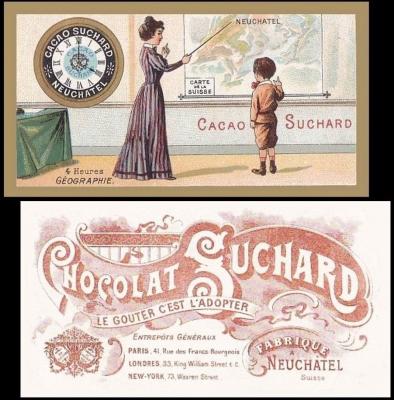
This card, ostensibly, could represent the way that children sit in school and stare at the clock, willing the hands to move fast so they can go out to play.
However it is more interesting than that, because this represents the most important thing about school, by far, and that is the way that a good teacher can tease out the interests of that child, and then inspire the children to find more things out, about whatever it is that interests them, for themselves.
Now these days we just put it in a search engine and let that do the work, then you copy and paste it to where you want to claim it as your own thoughts and words. It`s easy, and everyone does it, but that does not make it right, and it also does not teach you anything - in fact most people only look at the two words which start and close the piece they remove, they never even read the bit in the middle.
However, when this card was issued, the school would have had a collection of books, and if you wanted to know something you would go and look it up. And all manner of things were housed in those books, things you never dreamed of, things that could lead the children to a career, a sport, a hobby. Much as cigarette cards, especially the general sets, the "Do You Know`s, the "Guinea Gold`s", so many things were covered, and the hunger was not just to collect the set, but to find out more about the wonders of the world in which you lived.
This set has one thing in common and that is the big clock. Around our clock reads "CACAO SUCHARD NEUCHATEL", as additional advertising, of a subliminal nature. There is also advertising elsewhere on our card, look at the map, which is of Switzerland, the country in which our set was issued - not just that, but see how the teacher is pointing her baton at Neuchatel, the town where the chocolate is made, the only name on the entire map. Then, just to make sure you do not miss these, "CACAO SUCHARD" is also on the wall below the map.
- 1 Heure - Jeux (play)
- 4 Heures - Geographie
- 7 Heures - Reveil (sleep)
- 9 Heures - Lecture
- 10 Heures - Recreation (games)
- 11 Heures - Sortie d`Ecole (leaving school for the day) - the man is putting up a Suchard poster
I can`t find any more, though this is six cards, which is traditionally the length of most of not all of the Suchard sets. And I also cannot find a series number. So do help out if you can.
Friday, 5th September 2025
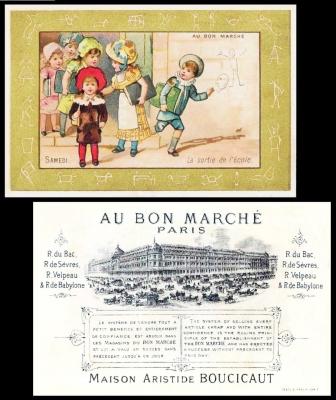
This card brings the week neatly to a close, for it shows something that happens every weekend, the school gets closed and the children get a couple of days off for play.
It is a most attractive set, with that heavy gilt border, and the little characters that dance about it are different on each card.
Even better, they were printed by Testu et Massin, also of Paris.
By the way the name suggests this ought to be a set of seven cards, but it is just six, Monday to Saturday. And that is settled when I found the set is entitled "La Semaine Scolaire", or the school week.
- lundi (Monday) - le rentree des classes (the return to school)
- mardi (Tuesday) - lecon de lecteurs (learning the alphabet)
- mercredi (Wednesday) - cours de geographie (geography lessons)
- jeudi (Thursday) - la grande marche (exercises)
- vendredi (Friday) - jour de larmes (day of tears) no idea what that means!
- samedi (Saturday) - la sortie de l`ecole (leaving school)
- dimanche (Sunday) -
P.S - I have just been told that you can see all the cards at hobbytime.org/ABM.32
